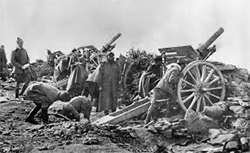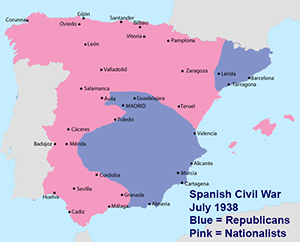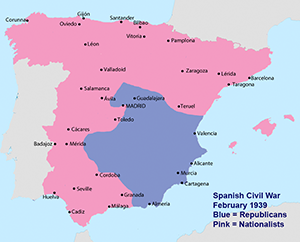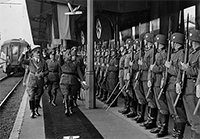Francisco Franco: Spanish General, Dictator
Part 2: Victory and Devastation
Once other rebels took Seville, Franco's troops swooped in and took Cádiz. By October, Franco had been identified as head of state and had set up a rival government in Burgos. The rebel force had more men, more weapons, and more friends. Still, government forces held much territory, including Madrid, in 1937. Juan Negrín had replaced Caballero as head of the government. By this time, the conflict had emerged as a clash of supporters of opposing political ideologies. Declaring support for the beleaguered Republic were Mexico, which sent money and weapons, and the Soviet Union, which sent troops, tanks, and many military advisors. France, the United States, and the United Kingdom were officially neutral, but a large number of people from both countries made their way to Spain and fought for the government, as part of the International Brigades. 
A Nationalist air raid in April 1937 left the city of Guernica in ruins. Nationalist forces claimed Bilbao two months later. By October, Nationalists controlled much of the western half of the country but had yet to take Madrid or other key cities under Republican control elsewhere. However, the presence of a large number of professional soldiers on the side of the Nationalists began to make a difference. Republican armies had trained soldiers, too, but they also had a large number of volunteers. 
Franco, firmly control of the military effort, also enjoyed solidarity of the coalition arrayed behind his effort to overthrow the government. Chaos, however, consumed the Republican efforts to defend themselves, as two main Communist factions faced off against each other in the midst of the war. Government forces sought to negotiate a cease-fire in May 1938, but Franco insisted on unconditional surrender and so on the fighting went. Dominating the second half of that year was the Battle of Ebro, an attempt by Republican forces to shore up their territory. It ended well, for Franco, who pushed on into Catalonia. 
When Franco's troops took Barcelona in January 1939, France and the U.K. agreed to recognize the general as the military leader of what would be a new government. The Nationalists' taking Madrid in March all but sealed the surrender that came the following month. Tens of thousands of refugees fled over the border into France. Franco took over the government and served as dictator. Both sides had made a habit of executing prisoners of war and political prisoners. After the war, Franco and others set up tribunals to try and convict as war criminals those who supported the Republican side but didn't flee to France or other countries. The one-man government also reinstated the supremacy of the Catholic Church. 
Despite the contributions of Germany and Italy during his victory, Franco didn't return the favor during World War II. Franco met with the German leader, Adolf Hitler, at Hendaye, France, in October 1940, but the meeting didn't result in an alliance. Franco wanted a large infusion of money and the right to occupy French holdings in northern Africa, but Hitler refused on both counts. Spain did send about 50,000 soldiers to fight with Germany on the Soviet front and had an open border with Axis troops for a time; however, Franco recalled his troops in October 1943 and openly supported the Allied powers. Spanish troops took advantage of the wartime situation and took control Tangier, a city under international control, in 1940; the troops stayed there until the end of the war, in 1945. Next page > The Dictatorship > Page 1, 2, 3 |
|
Social Studies for Kids
copyright 2002–2025
David White



 By the summer of 1936, plans were in place to topple the government. The flashpoint was the assassination on July 13 of the far-right political leader José Calvo Sotelo. The revolution began in earnest on July 18. A secret plane flew Franco (right) to Morocco, to head up the army there. That group spearheaded the drive for a military takeover on the mainland. The Spanish navy had refused to take part in the uprising, and so Franco's troops had to depend on transport from planes provided by Germany and Italy, both of which found ideological agreement with the Spanish Nationalists and both of which had sent military weapons and equipment. Meanwhile, in the north, General Emilio Mola commanded a Nationalist force bent on absorbing all points south to Madrid.
By the summer of 1936, plans were in place to topple the government. The flashpoint was the assassination on July 13 of the far-right political leader José Calvo Sotelo. The revolution began in earnest on July 18. A secret plane flew Franco (right) to Morocco, to head up the army there. That group spearheaded the drive for a military takeover on the mainland. The Spanish navy had refused to take part in the uprising, and so Franco's troops had to depend on transport from planes provided by Germany and Italy, both of which found ideological agreement with the Spanish Nationalists and both of which had sent military weapons and equipment. Meanwhile, in the north, General Emilio Mola commanded a Nationalist force bent on absorbing all points south to Madrid.
